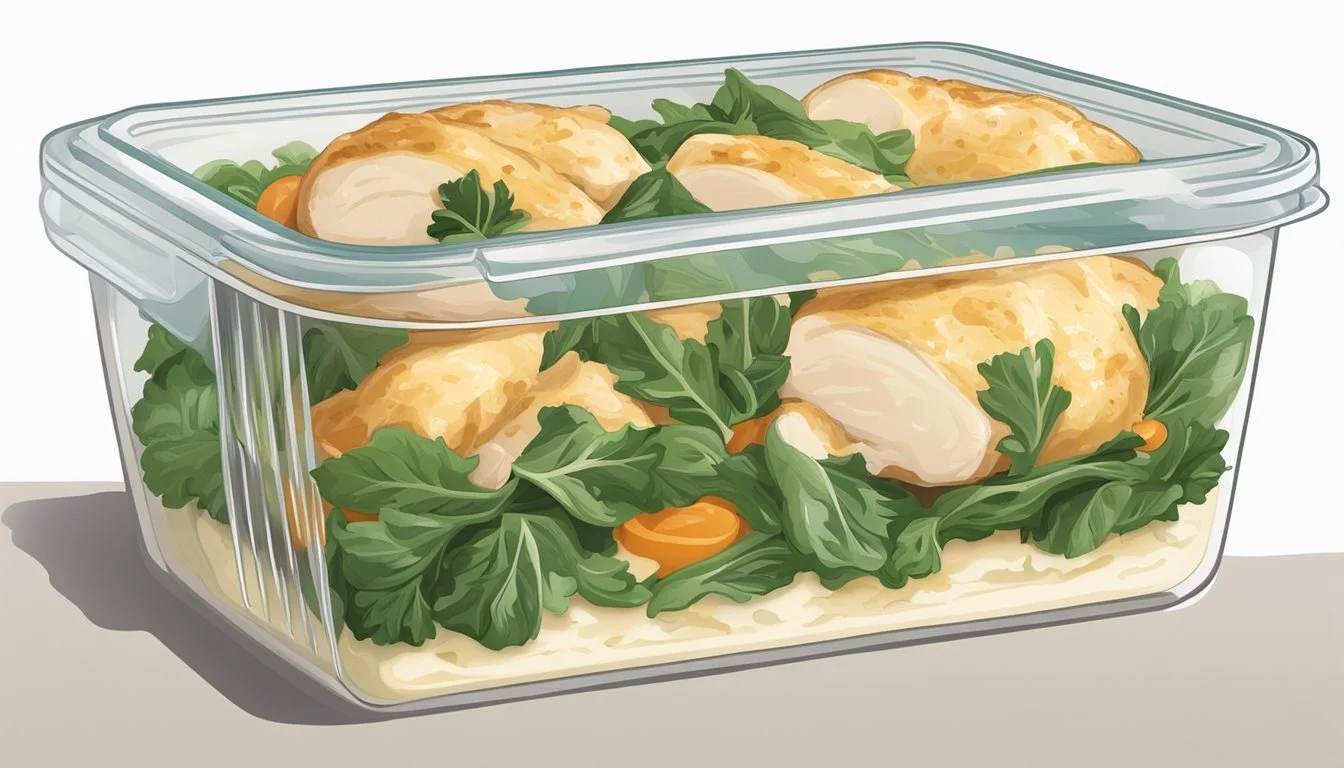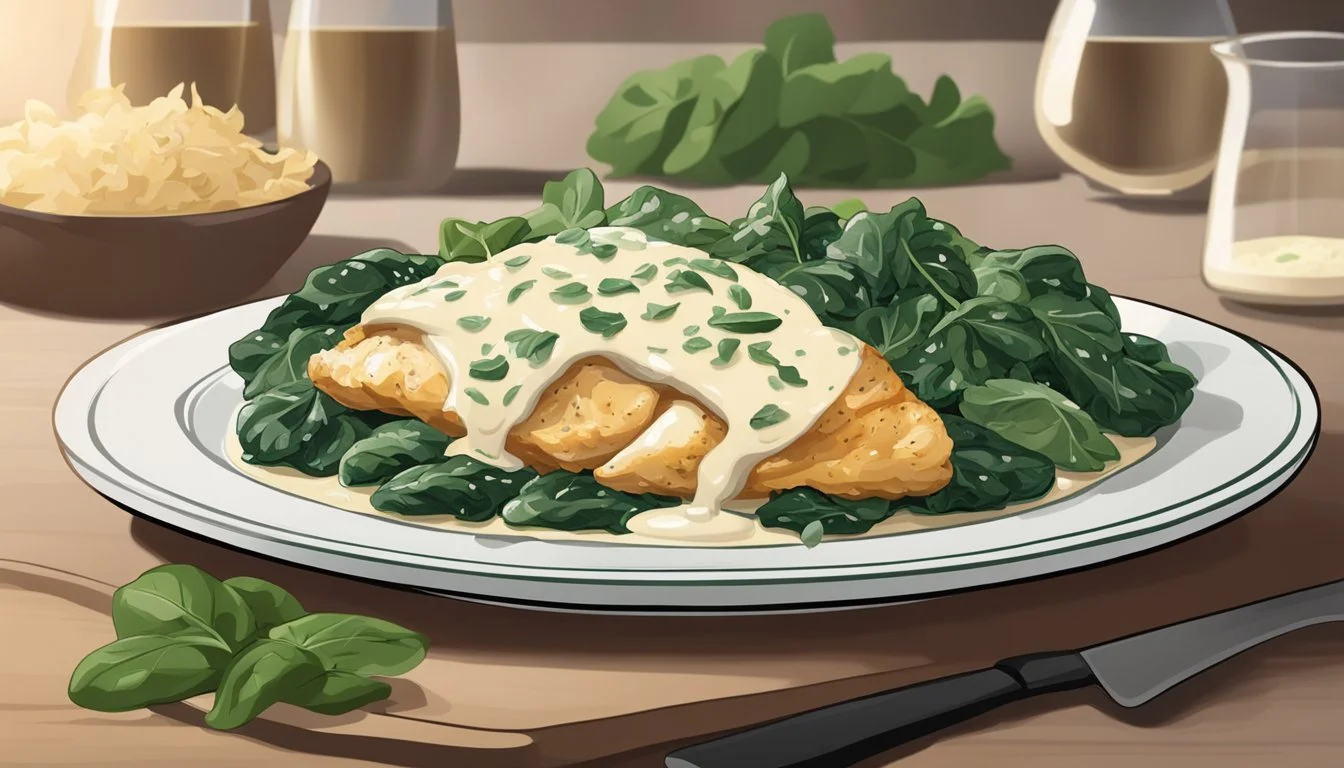How Long Does Chicken Florentine Last?
Storage Tips and Shelf Life
Chicken Florentine is a delightful dish featuring tender chicken breasts cooked in a creamy spinach sauce, often enjoyed with pasta, rice, or bread. But for those who make more than they can eat in one sitting, a critical question arises: "How long does Chicken Florentine last?"
When properly stored in an airtight container, Chicken Florentine can last in the refrigerator for up to 3-4 days. It's essential to cool the dish to room temperature before refrigerating to maintain quality. If you need to store it for a longer period, freezing it can extend its life to about 2-3 months.
To ensure the best taste and texture, recommanded reheating methods include using the stovetop or oven, rather than a microwave. This can help maintain the creamy consistency of the sauce and avoid drying out the chicken.
Understanding Chicken Florentine
Chicken Florentine is a classic dish that combines chicken, spinach, and a rich, creamy sauce. It has its roots in Italian cuisine and exemplifies the elegance of Florentine cooking.
Origins of Florentine Cuisine
Florentine cuisine originates from Florence, Italy. This region is known for its simple yet flavorful dishes that often emphasize fresh, local ingredients.
Florentine dishes frequently use olive oil, garlic, and fresh herbs. Florence has a rich culinary tradition and has significantly influenced Italian gastronomy.
What Makes a Dish 'Florentine'
A dish labeled "Florentine" typically includes spinach and is prepared in a method reflective of Florentine culinary traditions. This means using fresh ingredients and often a sauce enriched with cream, butter, or cheese.
The use of spinach is actually a tribute to Catherine de' Medici, who was known to favor it. Dishes like Chicken Florentine embody these elements.
Key Ingredients in Chicken Florentine
Chicken forms the base of the dish. It is usually boneless and pan-seared or lightly fried until golden.
Spinach is a crucial component, often sautéed and incorporated into the rich, creamy sauce made from cream, butter, and Parmesan cheese. Garlic and onions are also commonly added for flavor.
The resulting dish is creamy, savory, and deeply satisfying, reflecting the sophistication of Florentine cuisine.
Preparation Techniques
Creating the perfect Chicken Florentine involves careful preparation of the chicken, a rich creamy spinach sauce, and the final assembly of the dish. Each step requires attention to detail to ensure that the flavors meld perfectly.
Cooking the Perfect Chicken
To start, season the chicken breasts with salt and pepper. For even cooking, pound each chicken breast to an even thickness, around 1/2 to 1 inch.
Dredge the chicken in flour to create a light coating. This helps achieve a golden-brown crust. Heat a skillet over medium-high heat with butter or olive oil and cook the chicken for about 5 minutes per side until browned and cooked through.
Creating the Creamy Spinach Sauce
Simmer the cream and chicken stock together with spices such as garlic, black pepper, oregano, thyme, and marjoram.
Incorporate freshly grated Parmesan cheese for depth of flavor. Stir frequently to thicken the sauce slightly.
Add fresh spinach to the sauce and cook until it wilts, which takes about a minute. This combination creates a rich, velvety sauce that pairs perfectly with the chicken.
Assembling the Dish
Combine the cooked chicken and the spinach sauce in the same skillet. Allow the chicken to simmer in the sauce for a few additional minutes to absorb the flavors.
This step ensures that the chicken remains moist and infused with the creamy spinach mixture.
Serve the Chicken Florentine over a bed of pasta, rice, or mashed potatoes, garnished with a sprinkle of freshly grated Parmesan cheese for a final touch.
Proper Storage and Handling
Proper storage and handling of Chicken Florentine ensure that it remains safe to eat and maintains its quality. Key practices include refrigeration and monitoring for signs of spoilage.
How to Store Chicken Florentine
To store Chicken Florentine, use an airtight container and place it in the refrigerator at or below 40°F (4°C). This keeps the dish fresh for 3-4 days. If storing larger portions, divide them into smaller containers to cool more evenly and swiftly.
For longer storage, freeze Chicken Florentine. Use a freezer-safe container, and place cooled leftovers in it. Label the container with the storage date. Frozen Chicken Florentine can last up to 2-3 months.
Always reheat leftovers to an internal temperature of 165°F (74°C) using a food thermometer to ensure safety. Avoid leaving cooked chicken at room temperature for more than two hours to prevent bacterial growth.
Determining Spoilage
Check for spoilage before consuming stored Chicken Florentine. Visible mold, discoloration, and off smells are clear indications of spoilage.
Use a food thermometer to ensure reheated chicken reaches 165°F (74°C). Improper reheating can allow bacteria to persist.
If unsure of the freshness, discard the dish to avoid potential foodborne illness. Trust sensory indicators—smell, color, and texture—to gauge the condition of the stored chicken.
Safety and Shelf Life
Proper storage is essential to maximize the shelf life of chicken Florentine. Key factors include maintaining the optimal refrigeration temperature and understanding expiration and best before dates.
Optimal Refrigeration Temperature
Refrigerated chicken Florentine should be kept at a temperature of 40°F (4°C) or lower. This temperature slows bacterial growth significantly, reducing the risk of foodborne illness. Experts recommend using a reliable refrigerator thermometer to monitor the temperature.
To ensure even cooling, store chicken Florentine in shallow, airtight containers. This method promotes quicker cooling and prolongs freshness.
Do not leave cooked chicken Florentine at room temperature for more than two hours. If the room temperature exceeds 90°F (32°C), the time reduces to one hour. Prompt refrigeration is necessary to maintain safety and quality.
Expiration and Best Before Dates
Cooked chicken Florentine typically lasts 3 to 4 days in the refrigerator when stored correctly. Pay close attention to preparation and purchase dates. If freezing, it should be transferred to the freezer before the 4-day refrigeration period ends.
When frozen, chicken Florentine maintains its best flavor for up to 3 months. Use airtight packaging or vacuum-seal bags to minimize freezer burn and preserve taste.
Always adhere to the "best before" dates on pre-packaged components used in the dish. When in doubt, prioritize safety and quality by consuming prepared chicken Florentine within recommended timeframes.
Serving Suggestions
When serving Chicken Florentine, complement it with flavorful sides and a well-chosen wine. These additions enhance the dish's rich, creamy profile and provide a balanced meal.
Pairing with Sides
Chicken Florentine pairs well with various sides. Pasta is a popular choice, with options like fettuccine or penne absorbing the creamy sauce beautifully. Rice, particularly wild or jasmine rice, also serves as an excellent base, soaking up the flavors.
Another option is potatoes. Roasted or mashed, potatoes provide a hearty contrast to the creamy dish. For a lighter option, consider a fresh salad. A mix of greens, cherry tomatoes, and a light vinaigrette can balance the richness of the Chicken Florentine.
Finally, don't forget crusty bread. A warm, crusty loaf is perfect for sopping up the delicious sauce, ensuring none of it goes to waste.
Wine and Chicken Florentine
Choosing the right wine can elevate the dining experience. When it comes to Chicken Florentine, a white wine is a natural match. A crisp Sauvignon Blanc offers bright citrus notes that cut through the creaminess, while a buttery Chardonnay can complement the dish's richness.
Pinot Grigio is another good option, providing a refreshing and slightly tangy flavor profile. If you prefer red wine, opt for a lighter variety like Pinot Noir, which can harmoniously blend with the chicken without overpowering it.
Serving these wine selections can bring out the best in your Chicken Florentine, making it a memorable meal.
Customizing Your Dish
Customizing Chicken Florentine allows for flexibility in ingredients, adaptation for dietary needs, and implementing various enhancements. Making appropriate changes can add variety while keeping the dish flavorful and delightful.
Ingredient Substitutions
Many ingredients in Chicken Florentine can be substituted without compromising the dish's essence.
Proteins: Instead of chicken, try using turkey cutlets or thinly sliced pork chops.
Vegetables: Substitute spinach with kale or Swiss chard. Sun-dried tomatoes can replace mushrooms for a different taste and texture.
Liquids: Instead of white wine, use chicken broth or a non-alcoholic white wine substitute. For the cream, half-and-half or coconut milk can be used for a lighter option.
Adapting for Dietary Restrictions
Adapting this dish for dietary restrictions ensures everyone can enjoy it.
Gluten-Free: Use gluten-free flour for dredging the chicken. Ensure the broth and other packaged ingredients are certified gluten-free.
Dairy-Free: Replace butter with olive oil or a dairy-free margarine. Use coconut cream or a nut-based creamer instead of heavy cream. Nutritional yeast can mimic the cheesy flavor in place of parmesan.
Low-Sodium: Use low-sodium broth and opt for fresh herbs over dry ones to reduce overall salt content. Avoid adding extra salt.
Enhancements and Variations
Enhancing Chicken Florentine can elevate its flavors and presentation.
Extra Ingredients: Adding sun-dried tomatoes or artichoke hearts can provide an additional layer of flavor. A splash of lemon juice brightens the dish, while fresh herbs like basil or parsley add a fresh note.
Serving Suggestions: Pair the dish with mashed potatoes, pasta, or rice. For a low-carb version, use cauliflower rice or zoodles (zucchini noodles).
Presentation: Garnish with fresh spinach leaves or a sprinkle of paprika. Arrange the chicken over a bed of sautéed vegetables or alongside a vibrant green salad for a visually appealing plate.
Customizing Chicken Florentine is a great way to tailor the dish to personal preferences and dietary needs, making it a versatile and crowd-pleasing meal.
Key Tips for Success
For best results with chicken Florentine, follow these simple tips to ensure a delicious and safe meal.
Use Proper Equipment: A large skillet with even heat distribution is essential. Opt for stainless steel or cast iron for consistent cooking. A food thermometer helps confirm that the chicken reaches an internal temperature of 165°F (74°C).
Keep it Fresh: Store any leftovers in an airtight container. In the refrigerator, chicken Florentine lasts about 3-4 days. For longer storage, freeze it for up to 2-3 months.
Prep in Advance: Prepping ingredients like garlic, onions, and chicken cuts ahead of time saves effort during actual cooking. This is especially useful for weeknight dinners.
Cook in Batches: If cooking for a large group, brown the chicken in batches to avoid overcrowding the pan. This ensures even cooking and perfect browning.
Reheat Properly: When reheating, heat the chicken Florentine on low to medium heat. This prevents overcooking and keeps the sauce from breaking. A lid helps retain moisture.
Use Quality Ingredients: Fresh spinach, good-quality chicken, and fresh herbs make a noticeable difference. High-quality cream and broth enhance flavor immensely.
Following these tips ensures that your chicken Florentine turns out perfectly every time, providing a delightful meal for any occasion.









